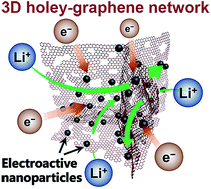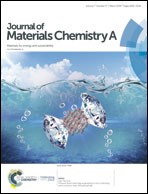Ultrafast Li-ion migration in holey-graphene-based composites constructed by a generalized ex situ method towards high capacity energy storage†
Abstract
Holey graphene is regarded as a promising upgrade of graphene in energy storage devices to expedite ion migration, but the scant surface groups of holey graphene hinder the in situ growth of electroactive materials, severely challenging its hybridization and further applications. Here we report a facile and generalized ex situ methodology to integrate various promising electroactive materials (e.g., Fe3O4, SnO2, MnO, and MoS2) on holey graphene, with ultrafine particle size and highly controllable loading contents. For example, monodisperse Fe3O4 nanoparticles (ca. 10 nm) with a high loading of up to 79 wt% are uniformly distributed on the highly interconnected holey graphene network. As an anode for lithium-ion batteries, the Fe3O4/holey-graphene composite (Fe3O4@3DhG) achieves 1516 mA h g−1 at 0.2 A g−1, and 554 mA h g−1 at 5.0 A g−1 for over 2500 cycles, exhibiting extremely high capacity, excellent rate performance, and marvelous cycling longevity. It is demonstrated that the conductive and hierarchically porous holey graphene backbones can not only facilitate the ion-/electron-transmission and accommodate the volume changes upon lithiation/delithiation, but also activate the surface-controlled capacitive effect to a transnormal level. Moreover, the outstanding performance of the full cells with LiFePO4 cathodes and Fe3O4@3DhG anodes reveals the immense potential in commercialization of such composites.



 Please wait while we load your content...
Please wait while we load your content...